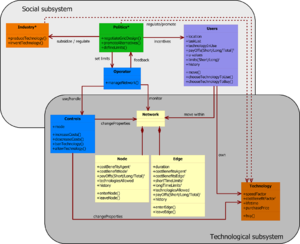Components and Features
As seen in the SimCo class diagram, there is a social subsystem and a technological subsystem. These subsystems show interactions within and among each other and are consequently interdependent.
Social subsystem
Currently, we habe implemented the following agent groups:
- Users, who move through the network, visiting nodes using different technologies,
- Operators monitoring and managing the system.
Later, we will complete the system by adding more agent groups, such as transport companies or technology producers.
Technological subsystem
The technological subsystem consists of the network (nodes, edges), technologies (e.g. car or bike) and controls that allow changing parameters.
Interactions
Social interactions
User agents interact with other users, e.g. producing a congestion. They collect and transmit information mostly via the technological subsystem and not via direct communication. This also applies to the interaction of users and operators.
Technical interactions
Neighboring nodes interact via edges which transmit information on adjacent nodes. Technologies interact with nodes or edges, which contain information about technologies allowed, while vice versa changing the state of nodes or edges by wearing them out. Controls may affect the properties of nodes, edges or technologies.
Socio-technical interactions
Both subsystems mutually affect each other. Users will change state parameters like occupancy rate of nodes/edges which in return constrain the users decisions (see Decision Making). Additionally users will decide between different technologies such as 'car' or 'bike'. These interactions may be influenced by interventions predefined in specific experiments.
- Go to the next page: Decision Making
